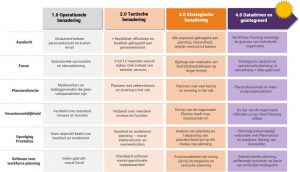With the rise of planning as a serious area of expertise, questions about what good, professional planning is, also come to the fore more often. In this article, we outline four stages of workforce planning that yield excellent personnel planning.
The need for optimisation
Many employees involved in planning answer the aforementioned question based on gut feeling. Naturally, not wanting to detract from the practical experience of planners and good intentions of employers, there is a need for more objective assessments of planning quality and efficiency. In many organisations there is such a thing as the ‘planning paradox’. The (top) management of the organisation declares that it considers personnel planning to be extremely important. However, this perspective then fails to be translated into how the planning should be carried out, which is a missed opportunity.
Is there any such thing as the perfect planning?
It goes without saying that the perfect planning doesn’t exist. After all, how planning is designed and managed differs between organisations. This always concerns ensuring that this is harmonised with, on the one hand the needs, and the other the nature of the organisation and its environment. If, for example, the work doesn’t involve a lot of variety (during the week during office hours), a simple system may be the appropriate choice. In other situations, however, a more advanced system of personnel planning may be required. Just consider, for example, the planning for an operating room in a large hospital where multiple schedules and plans have to be aligned.
The level and degree of subtlety attached to the workforce planning is linked to:
- The social-economic development of a region/country.
- The impact of the organisational vision on the planning and the significance attached to the theme.
- The external/internal factors that have to be coordinated with the planning.
Four levels of personnel planning
Déhora draws a distinction between four typical stages of workforce planning. These range from a more operational approach to a fully-fledged integration of workforce planning. The fourth stage of personnel planning is currently the ultimate goal or the most advanced form. The following levels provide an excellent basis for the assessment and optimisation of personnel planning. As you can imagine, working points intersect across the different levels. Look at the table below (in Dutch only); to what stage has your workforce planning progressed? And are you satisfied with this?

Do you have any questions about the 4 levels of personnel planning? Please don’t hesitate to contact us!
From ‘Workforce Planning: one size does not fit all!’ (Read the full (Dutch only) article here)
By Ben Jansen / CEO Déhora Consultancy Group and Chairman of the Time Design Foundation.

5 frequently made mistakes in workforce scheduling
Despite the fact that every planner works towards optimal planning and good schedules, things don't always go as planned. What are the most common mistakes and how can you go about solving them? An alert and cautious planner is worth two who don't go the extra mile.
